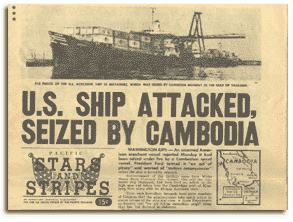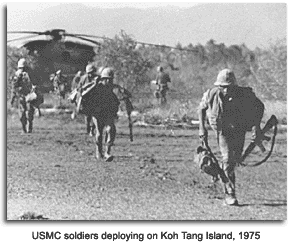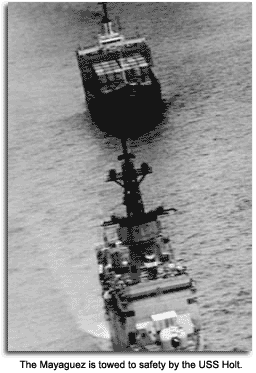A remnant of U.S. military forces departed from South Vietnam in April 1975 in what President Gerald Ford termed "a humiliating withdrawal." U.S. military involvement in southeast Asia had officially ended. But it wasn't over yet. In what many consider to be the final battle of the Vietnam War, the Mayaguez Incident remains in dispute.
On May 12, 1975, gunboats of the Cambodian Navy seized the American merchant ship, SS Mayaguez, in international waters off Cambodia's coast. The ship was being towed to Kompong Som on the Cambodian mainland when word reached the White House. President Ford was determined that the situation not be allowed to deteriorate into another drawn-out Pueblo incident. In addition, it was believed important to counter a growing perception among U.S. friends and adversaries that America was "a helpless giant" and an erratic ally lacking determination.
 The U.S. response to the seizure would be a military operation executed by an ad hoc force of airmen, marines, and sailors. The U.S. had no diplomatic relations with the Khmer Rouge, which had taken control of Cambodia in previous weeks. U.S. forces stationed in neighboring Thailand were numerically insufficient for ground action against Cambodia, and no U.S. warships were in the district.
The U.S. response to the seizure would be a military operation executed by an ad hoc force of airmen, marines, and sailors. The U.S. had no diplomatic relations with the Khmer Rouge, which had taken control of Cambodia in previous weeks. U.S. forces stationed in neighboring Thailand were numerically insufficient for ground action against Cambodia, and no U.S. warships were in the district.
Planning the rescue
Time was a compelling factor. The big concern was that the Cambodians would transfer the crew to the mainland, making the rescue operation more arduous. For those in authority to make an enlightened decision, it was necessary that more than one plan be considered. According to then Chief of Staff General David C. Jones, five plans were prepared. Option Four, a twin-pronged marine assault coupled with the bombing of selected targets, was Ford's choice. In such situations as hostage rescue attempts, planning is usually based on assumptions or speculation, especially during the first hours or days of the crisis. Intelligence data were sufficient for an operation with all its possibilities.
Within a few minutes of receiving the mayday message sent by the Mayaguez, Jim Larkins and his Ready Alert Bird were airborne. By 10:30 p.m., at Cubi Point Naval Air Station, Jim Messegee had received his first report on the Mayaguez. It was too dark for Larkins and his crew to eyeball the ship, but they could see a captured merchant vessel on their radar screens as a big image flanked by two little images.
Option Four was an extravagant scheme that employed two destroyers, one aircraft carrier, two marine units with 12 helicopters, a generous complement of Air Force fighters, bombers, and reconnaissance aircraft. President Ford believed strongly that it was better to use too much force than too little. Ford ordered the aircraft carrier Coral Sea and other navy ships to proceed at full speed to the Gulf of Thailand, as well as planes in the Philippines to locate the Mayaguez and keep it in view. A Navy P-3 located the ship anchored off Kho-Tang Island, 40 miles from Cambodia. Several observance aircraft were damaged by gunfire from the island.
A battalion-sized marine rescue team was airlifted from Okinawa to U-Tapao Airforce Base in the Gulf of Thailand, about 300 miles from Kho-Tang. The destroyer USS Holt was directed to seize the Mayaguez, while Marines, airlifted and supported by the Air Force, would rescue the crew, at least some of whom were believed to be held on Kho-Tang. Concurrently, the Coral Sea would launch four bombing strikes on military targets near Kompong Som to convince the Khmer Rouge that the U.S. was serious.
 Once more unto the breach*
Once more unto the breach*
Expecting only light resistance, the U.S. troops were met by a force of 150 to 200 heavily armed Khmer Rouge soldiers who shot down three of the first eight helicopters and damaged two others. About 100 marines were put ashore, but it soon became clear that substantial reinforcements would be needed. The assault force was supported by Air Force planes, but the attack was not going well.
While the firefight on Kho-Tang was at its most intense, bombing targets on the mainland apparently convinced the Khmer Rouge leaders that they had underestimated U.S. resolve. A fishing boat was seen to approach the destroyer Wilson with white flags flying. Aboard were the 39 crewmen of the Mayaguez.
The marines on Kho-Tang were ordered to disengage and withdraw. However, Khmer Rouge troops, perhaps directed by a local commander, continued the battle, turning from defense to offense as Air Force helicopters moved through heavy fire to withdraw U.S. forces. The last of 230 marines were not evacuated until after dark on the night of May 15. As they had throughout the Vietnam War, helicopter crews performed with unsurpassed heroism.
Eighteen Marines and airmen were killed or missing in the assault and withdrawal from Kho-Tang. Twenty-three others were killed in a helicopter crash en route from Hakhon Phanom to U-Tapao, but the objectives of the operation were achieved. The Mayaguez and its crew had been rescued, though at high cost.
 Epilogue
Epilogue
The Mayaguez incident is no more than a footnote in most histories of the period. The ship, crew and men who carried out the rescue deserve better than that. At a time when its resolve was in doubt, the U.S. showed the world that it would pay whatever price was necessary to protect its citizens and preserve its national honor.
"Once more unto the breach, dear friends, once more; Or close the wall up with our English dead. In peace there's nothing so becomes a man As modest stillness and humility: But when the blast of war blows in our ears, Then imitate the action of the tiger; Stiffen the sinews, summon up the blood..."